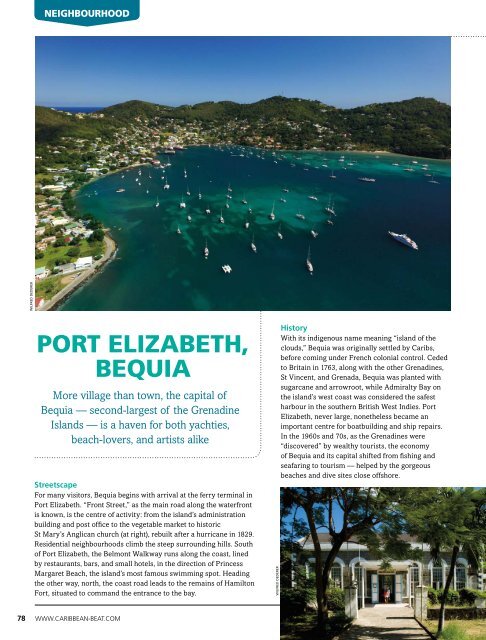Caribbean Beat — 25th Anniversary Edition — March/April 2017 (#144)
A calendar of events; music, film, and book reviews; travel features; people profiles, and much more.
A calendar of events; music, film, and book reviews; travel features; people profiles, and much more.
Create successful ePaper yourself
Turn your PDF publications into a flip-book with our unique Google optimized e-Paper software.
NEIGHBOURHOOD<br />
wilfred dederer<br />
Port Elizabeth,<br />
Bequia<br />
More village than town, the capital of<br />
Bequia <strong>—</strong> second-largest of the Grenadine<br />
Islands <strong>—</strong> is a haven for both yachties,<br />
beach-lovers, and artists alike<br />
Streetscape<br />
For many visitors, Bequia begins with arrival at the ferry terminal in<br />
Port Elizabeth. “Front Street,” as the main road along the waterfront<br />
is known, is the centre of activity: from the island’s administration<br />
building and post office to the vegetable market to historic<br />
St Mary’s Anglican church (at right), rebuilt after a hurricane in 1829.<br />
Residential neighbourhoods climb the steep surrounding hills. South<br />
of Port Elizabeth, the Belmont Walkway runs along the coast, lined<br />
by restaurants, bars, and small hotels, in the direction of Princess<br />
Margaret Beach, the island’s most famous swimming spot. Heading<br />
the other way, north, the coast road leads to the remains of Hamilton<br />
Fort, situated to command the entrance to the bay.<br />
wilfred dederer<br />
History<br />
With its indigenous name meaning “island of the<br />
clouds,” Bequia was originally settled by Caribs,<br />
before coming under French colonial control. Ceded<br />
to Britain in 1763, along with the other Grenadines,<br />
St Vincent, and Grenada, Bequia was planted with<br />
sugarcane and arrowroot, while Admiralty Bay on<br />
the island’s west coast was considered the safest<br />
harbour in the southern British West Indies. Port<br />
Elizabeth, never large, nonetheless became an<br />
important centre for boatbuilding and ship repairs.<br />
In the 1960s and 70s, as the Grenadines were<br />
“discovered” by wealthy tourists, the economy<br />
of Bequia and its capital shifted from fishing and<br />
seafaring to tourism <strong>—</strong> helped by the gorgeous<br />
beaches and dive sites close offshore.<br />
78 WWW.CARIBBEAN-BEAT.COM


















